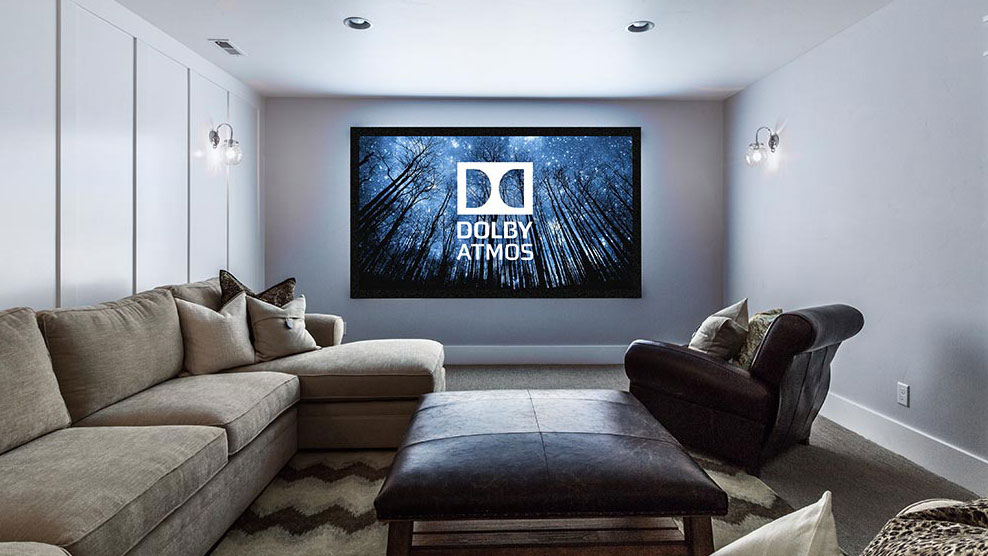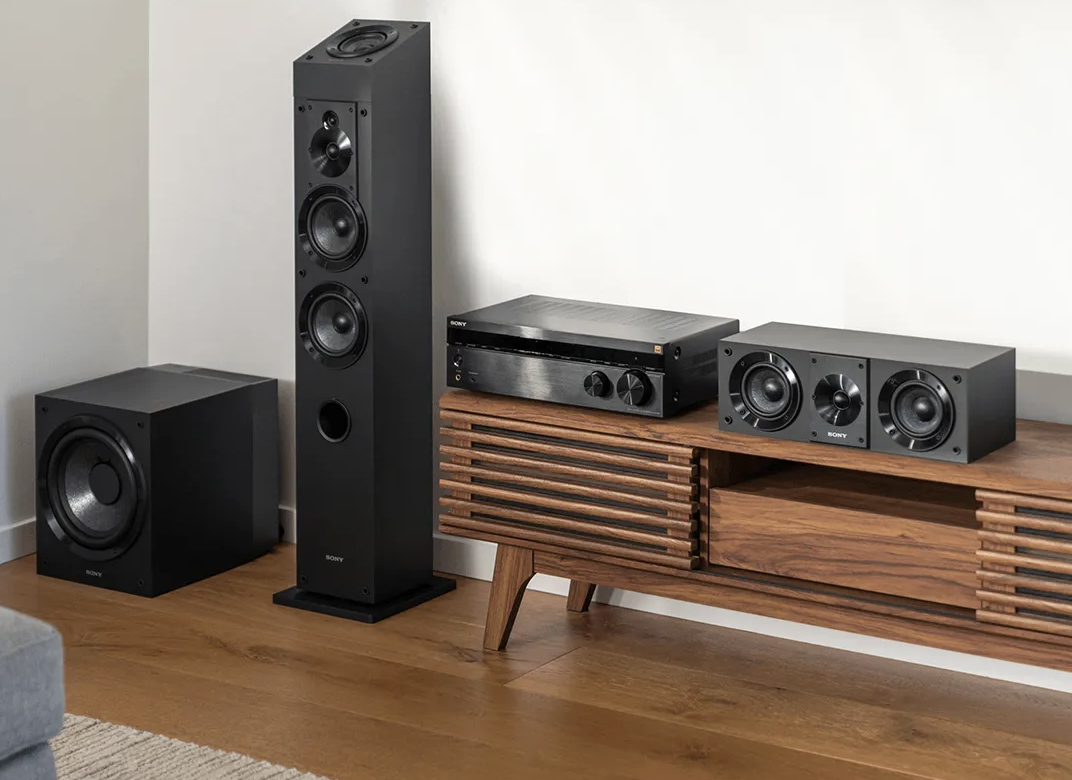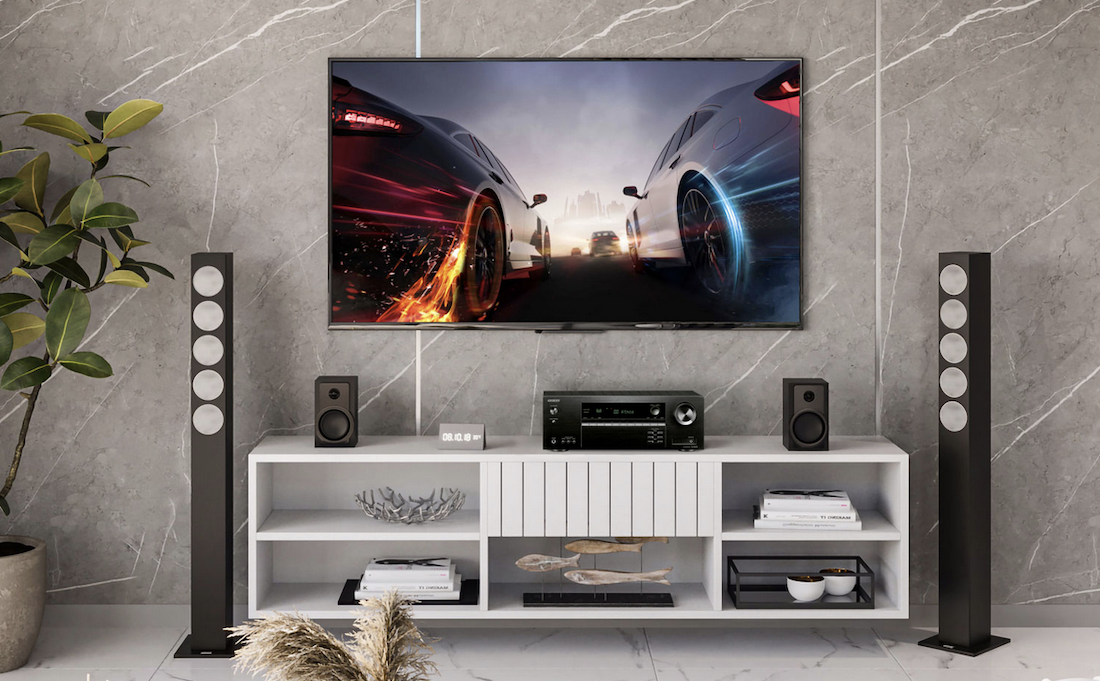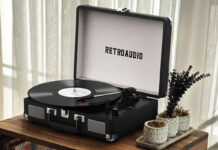
Thanks to today’s home theatre audio systems, its never been easier to replicate the soundscapes from the latest blockbusters, or even surround music mixes from some of your favourite artists, in the comfort of your home. Thanks to object-based mixing technologies like Dolby Atmos, and the powerful systems that reproduce these audio streams, consumers are now able to not only entertain themselves with speakers with audio information coming out at ear level, but have the addition of height-channels to quite literally surround the listener in ways more immersive than ever before.
There are various ways to get Atmos into your home setup, including soundbars that provide a virtual approximation of a multi-channel, multi-location speaker setup. Yet to get the biggest bang in your home theatre room it’s best to invest in a capable receiver, along with speakers that are designed to not only provide clean and clear audio, but to allow you to fully experience the audio wonders of true Atmos in all its glory.
What is Atmos?
Simply put, Atmos (like DTS-X and other similar codecs) augments a traditional surround sound setup with additional speakers, with sound information placed above listening position rather than simply emitting at ear-level, which previous setups were limited to. The technology is driven in part on object-based mixing technologies, meaning that the soundtrack from your favourite movie either on disc or top-tier streaming is capable of conforming to the number of speakers in your own setup. Powerful processing in modern receivers recognizes whether you have a 5 or 7 channel setup at ear level, how many individual subwoofers you have placed around the room, and how many speakers you have dedicated for the height channels.
For over ten years now we’ve been able to experience this amazing advancement in cinema sound in our own homes. While cinemas can use dozens and dozens of individual channels to replicate the intents of the mixer, at home this same mix can be “folded down” to fit your exact setup, meaning that whatever number of speakers you have, the audio will fit your exact setup. There’s more information that can be found about how these soundtracks work, but suffice it to say, moving to an Atmos setup truly does provide an entirely new dimension for your audio bliss.
What speakers do you need for a Dolby Atmos home theatre?

At its most simple, if you’ve decided you have the space and budget to experience Atmos using a true multi-speaker setup, with the various soundsources located around your room (rather than, say, a soundbar located in front of your display), then you’re going to be looking at a fair number of speakers for your setup. Luckily, many of us already have existing surround setups that were optimized for previous surround schemas such as 5.1 or 7.1.
With previous surround modes such as Dolby TrueHD, the key speakers would be the the front left and rights, the center channel, and either two or four surround channels, either located slightly behind the listener, or in the case of a 7ch setup to the side and the rear of center. The .1 designates the “LFE”, or dedicated bass channel that’s transmitted to a subwoofer.
With Atmos, you’re adding two or more speakers to this equation, for, say, a 5.1.2, or a 7.1.4 setup, depending on what your receiver is capable of decoding. Certain high-end processors are able to accommodate these dozens of channels with ease, rivaling even the multiplex for the number of speakers you can cram into your room.
The types of speakers can differ quite dramatically. For your front left and right speakers, many people choose models that provide full range sound, so that when listening to a stereo soundtrack they’re not limited by the frequency response. Thanks to modern subwoofers, however, the need for full-towers has been reduced in some ways, and in an ideal setup all your ear-level speakers are actually capable of providing clean and clear audio in equal measure, with some bass frequencies potentially redirected to your sub to help provided the low-end punch.
Just like the subwoofer is a specific type of speaker purpose built for low-frequency reproduction, many height channel options are similarly designed explicitly for the reproduction of these more ambient elements from the soundtrack, often providing a less directional sound meant to fill out that audio space. Some are designed to bounce up and off the ceiling, some are mounted directly in the ceiling, while others are located either in front or up and to the side to create a diffuse yet impactful augmentation to your regular surround setup.
An important note:
Atmos, like other surround elements, augments the key elements of the main soundtrack that in the vast majority of cases is focused on the front, where the left, center and right channels do much of the heavy lifting. When investing in your setup, make sure that you aren’t limiting these speakers more than any other, and if building up over time investing in quality fronts/center should be considered a priority, while the other channels can be expanded over time.
Setting up your Dolby Atmos home theatre system

Every modern receiver that is Atmos compatible has an easy-to-use setup mode, with a graphic interface that facilitates the positioning and setup of your various speakers. In an ideal situation you’d be starting with a blank canvas, a room where you’re free to locate each speaker in its perfect position, and perhaps even place the various wires within the walls to keep things neat and tidy. While this isn’t always able to be accomplished, it’s ideal for anyone who is planning for their dream home theatre to make careful decisions about speaker placement well in advance. After all, while your equipment may change, certain fundamentals about placement will not, meaning you can start out with a relatively modest system if you’re planning ahead for a future upgrade.
1. Position your speakers
Once you’ve decided on the scope of your Atmos setup, the position of each speaker is predetermined in pretty fundamental ways. The “regular” surround speakers (either 5 or 7 channels) should be placed around ear level, ensuring that the distances of paired speakers (such as, say, side-surrounds) are as equidistant to the listening position as possible. For the augmentation of Atmos channels, you have several options.
First, you can ceiling mount if you have high enough clearance, placing two or more in pairs. For the full Atmos effect I’d recommend a minimum of four (two just in front and above of listening position, two just above and behind), perhaps even restricting your ear-level surrounds to 5 channel in order for your receiver to drive all these signals.
A second, similar option (one I personally employ in my low-ceiling room) are directional speakers mounted higher up and aimed slightly towards the listener. This allows a clear delineation between the ear-level mix and those mounted above.
A third option uses top-firing speakers, often placed atop your front channel towers. These are designed to bounce signals up and off the ceiling to the central listening position. While I’m not the biggest fan of this solution, it remains a perfectly acceptable way of moving forward if that’s what works best for your space. Either way, the addition of these height channels will do wonders to expand the soundscape in your room, and if this is the best way in your particular setup then these type of speakers should seriously be considered.
2. Configure your receiver
Thankfully, much of the heavy lifting for configuring your receiver is done via easy-to-use setup features. Many systems include room correction technology as well, that use equalization curves to further dial in the sound and obviate any room particularities that can negatively impact playback. On models that accommodate it, a supplied microphone is put on a tripod at the listening position where levels, placement, and even phase is checked to ensure everything is correct. If your receiver does not have these exact features, you can readily use simple apps on your mobile device along with test-tones generated from your unit to ensure that everything has the same relative sound level.
Once setup, you want to ensure that each device you are adding to your setup, from streaming box to game console to disc player and beyond, are set to provide the maximum level of channels. Often a setting of “auto” or “bitstream” is sufficient to set and forget, letting the powerful processor in your receiver decode these sound signals and fill your room.
3. Find Atmos content
Atmos content really has never been easier to experience than it is now. Major streamers such as Netflix, Disney, Apple, and Primevideo have incorporated these mixes into many of their releases. Most new TVs even allow you to send the signals via eARC back to your receiver, allowing full surround even from built-in apps on the set. Hundreds of Blu-ray and 4K UHD discs have multichannel Atmos mixes, with some of the most exhilarating films ever made providing amazing sound right from your own setup.
In a relatively new exciting development, music streaming services such as Tidal, Apple, and others have unique Atmos surround mixes for some of the most popular records of all time, encouraging you to experience favourites in an entirely new and immersive way. Finally, modern game consoles allow for Atmos-compatible soundtracks, perfect for using multiple senses to be able to track the action, with multi-speaker setups ideal for being able to precisely position a given sound source.
Is Dolby Atmos right for you?
It’s fair to say that moving into the world of Atmos, particularly using a receiver with a true multi-speaker setup, isn’t the most convenient or simple solution. Still, a properly setup and calibrated speaker layout, combined with the powerful capabilities of modern receivers, means the end results are truly astounding. When you finally get to sit back and experience Dolby Atmos in all its glory within the confines of your home it’s hard to see how you won’t be swayed by the effect. Simply put, a receiver/multi-channel speaker combo is the ultimate for any home theatre, and while at first it may feel overwhelming, taking the time to do your research, and not being afraid to build up with elements over months or years will produce tremendous results. All home theatre builds are journeys, and for those willing to go on this path the rewards are immense.
There are many Dolby Atmos receivers and Dolby Atmos speakers available at Best Buy, and whether you’re just starting to planning your own immersive home theatre, or hoping to build upon a previous setup, there are many solutions that fit a variety of budgets and applications.






